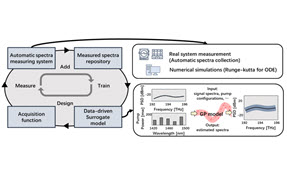Extending the reach of mosaic pixel IR focal-plane arrays
Microbolometer IR focal-plane-arrays (IRFPAs) are used extensively in thermal imaging, with market growth estimated to increase from 250,000 units in 2010 to 750,000 in 2015.1 This prediction covers industrial thermography, which is used (among other things) for building inspection and preventive maintenance, and both commercial and military vision markets. With the exception of automobile applications, however, it does not include the anticipated very high volume consumer and industrial markets for cheap IR sensor products, such as fire detectors and high-performance security sensors.
Resistance microbolometer IRFPAs are manufactured by microelectromechanical systems (MEMS) processing and have become the primary technology for small, compact IR imaging sensors because they can operate efficiently without cryogenic cooling (thus so-called uncooled). The sensor cost has fallen with time and competition, but is still an order of magnitude too high for very high volume consumer and industry markets. At Electro-optic Sensor Design (EOSD), we have developed a novel IRFPA concept specifically for passive IR (PIR) security sensors.2 We are now extending the technology to a range of high-performance, low-cost products.3
The mosaic pixel FPA (MP-FPA) design concept4 involves forming a pixel from a mosaic of functional, electrically interconnected sub-pixel microbolometers that may be connected as a parallel, series, or parallel-series resistance network. Compared to a single microbolometer pixel (as in a conventional IRFPA), an MP-FPA can be designed to change the detector resistance, reduce electronic noise, and modify thermal conductance and thermal capacitance while retaining the same pixel area. This offers a number of advantages, particularly for large pixels used in short-range detection. Figure 1 shows a mosaic pixel with four sub-pixel microbolometers. The bolometers can be interconnected at the substrate or within the bolometer body, as indicated in the figure.
We initially developed this technology for a new generation of PIR security sensors.5 It soon became evident, however, that the MP-FPA concept could be applied to many other applications, including fire detection, pedestrian detection, human or animal monitoring, and industrial production control. First, we noted that a cheap IR sensor fabricated by MEMS technology could be packaged with a global positioning system chip and radio frequency identification tag to give the position and status of the sensor. This would be used, for example, to alert and direct emergency services to a forest fire. This sensor concept is known as the Internet of Things.6 Second, we also recognized that different MP-FPA formats could be employed to modify and enhance the performance of conventional thermal imagers.
Small-format non-imaging MP-FPAs designed for PIR security sensing have sub-pixel microbolometers interconnected in parallel to achieve an optimal compromise between sensitivity and speed of response. The sensitivity of a sensor is measured as a noise equivalent temperature difference (NETD) of 100mK when packaged in nitrogen at atmospheric pressure. When packaged in vacuum, the same sensor has an NETD of <10mK. This exceptional performance applies to 25μm sub-pixel microbolometers fabricated with either amorphous silicon or vanadium oxide technology. It suggests significant future potential for high-sensitivity IR detection and non-contact temperature measurement.
We are investigating the application of MP-FPA technology to large format, small-pixel thermal imaging using serial-parallel sub-pixel microbolometers. Conventional single-bolometer pixels can be modified to meet different applications or to improve mechanical strength and reliability, hence boosting production yield. For example, the mosaic pixel in Figure 1 could be serial-parallel interconnected, providing the same performance as a single-bolometer pixel but with a more robust mechanical structure. This can be achieved with a minor change in photomask design. MP-FPA technology can also be employed to significantly enhance the performance of currently produced thermal imagers. We have designed a 4×4 series-parallel mosaic pixel (see Figure 2) for implementation in low-cost handheld cameras used for preventive maintenance and other diagnostic applications. A small modification in FPA design to a standard 320×240 format FPA can reduce the NETD from a typical 100 to <25mK, enabling operation where currently only much higher performance cameras are acceptable.

Mosaic pixel FPA technology performs exceptionally well in many applications. We are working on forest-fire detection, high-sensitivity sensors, and enhancements for thermal imagers currently in production. We are also investigating fabrication of MP-FPA in a CMOS/MEMS foundry. EOSD and its development company, IR Sensors, are seeking development partners and intellectual property agreements.
Kevin Liddiard has conducted leading-edge research on low-light-level detection, radiometric signatures, and optical sensors. His best-known work is the invention of the silicon microbolometer and development of uncooled IRFPA and sensor systems.




